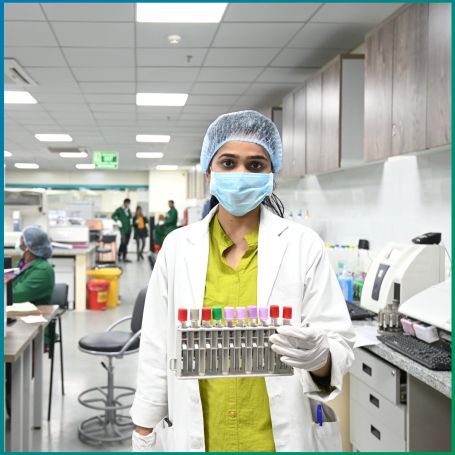
The C/S Urethral Discharge Test is an important diagnostic procedure used to detect infections in the urinary tract or reproductive organs.

A C/S (Culture and Sensitivity) Urethral Discharge Test involves collecting a sample of the discharge from the urethra (the tube through which urine is expelled from the bladder) and sending it to a laboratory for testing. The "Culture" part of the test refers to growing the microorganisms in a controlled environment to identify the specific pathogens responsible for the infection. The "Sensitivity" portion of the test involves exposing the cultured organisms to different antibiotics to determine which ones are most effective in inhibiting or killing the pathogen.
1] Identifying the Cause of Infection: The test helps identify the specific pathogen (such as bacteria, fungi, or viruses) causing the urethral discharge and associated symptoms.
2] Diagnosing Sexually Transmitted Infections (STIs): It is commonly used to diagnose STIs such as gonorrhea, chlamydia, and trichomoniasis, which often cause urethral discharge.
3] Antibiotic Resistance Testing: The sensitivity part of the test helps determine which antibiotics are effective against the identified pathogen, especially if the infection is resistant to certain medications.
4] Targeted Treatment: The test ensures that the patient receives the correct treatment by identifying the most effective antibiotics, reducing the chances of complications and recurrence.
5] Monitoring Recurrent Infections: For patients with recurring urethral infections or persistent symptoms, a C/S test can help determine if the infection is resistant to previous treatments and if a different antibiotic is needed.
1] Collection of Sample: A healthcare provider will use a sterile swab to collect a sample of the urethral discharge. This is typically done during a physical examination, and the swab is gently inserted into the urethra to collect the discharge. The sample should be taken as close to the source of the infection as possible to ensure accuracy.
2] Transporting the Sample: Once the sample is collected, the swab is placed in a sterile container and sent to a microbiology laboratory for culturing and sensitivity testing.
3] Culturing the Pathogens: In the laboratory, the sample is cultured on nutrient-rich media to encourage the growth of bacteria, fungi, or other pathogens present in the sample. This allows the laboratory technicians to identify the specific microorganism causing the infection.
4] Sensitivity Testing: After the pathogens are identified, they are tested against various antibiotics to determine which ones are effective in stopping the growth or killing the organisms. This helps the doctor prescribe the most appropriate antibiotic for treatment.
5] Result Interpretation: The test results, including the identification of the pathogens and their sensitivity to various antibiotics, are usually available within 2 to 5 days. The doctor will then discuss the results and recommend a treatment plan based on the findings.
At Diagnopein, we offer precise and timely C/S Urethral Discharge Tests to help diagnose and treat urethral infections effectively. Our state-of-the-art laboratory is equipped with advanced technology for accurate culturing and sensitivity testing, ensuring that we identify the exact pathogen responsible for your symptoms. With a team of experienced professionals, we provide a comfortable and discreet testing experience, prioritizing patient care and confidentiality. Our quick turnaround time for results allows your healthcare provider to prescribe the most appropriate treatment without delay, ensuring you receive the best possible care. At Diagnopein, we are committed to providing reliable, high-quality diagnostic services, making us your trusted choice for C/S Urethral Discharge testing.
1. Culture Method
2. Sample
3. Colony Count
4. Organism(s) Isolated
5. Culture Report: Culture yields growth of
6. Culture isolated after 7 days :
7. Culture isolated after 14 days:
8. Culture isolated after 21 days:
9. Ampicillin
10. Amikacin
11. Amoxicillin clavulanate
12. cefoperazon+sulbactam
13. Cefuroxime
14. Cefepime
15. Cefotaxime
16. Ciprofloxacin
17. Ertapenem
18. Gentamicin
19. Imipenem
20. Meropenem
21. Norfloxacin
22. Nitrofurantoin
23. Piperacillin-tazobactam
24. Trimethoprim-Sulfamethoxazole (Cotrimoxazole)
A healthcare provider collects a sample of discharge from the urethra using a sterile swab, which is then sent to the laboratory for culturing and sensitivity testing to identify the pathogen and effective treatments.
This test is used to diagnose infections in the urethra, particularly sexually transmitted infections (STIs) like gonorrhea, chlamydia, or trichomoniasis, and to guide appropriate antibiotic treatment.
The procedure is generally not painful, but some discomfort may occur when the swab is inserted into the urethra, particularly if the area is inflamed.
There are minimal risks, though irritation or slight discomfort may occur during the sample collection. There's no significant risk of infection if the procedure is done in a sterile environment.